Analyzing Contemporary Issues and Challenges in Cruise Tourism
VerifiedAdded on 2021/10/13
|12
|3052
|55
Essay
AI Summary
This essay delves into the multifaceted contemporary issues affecting the cruise tourism industry. It examines environmental concerns such as waste management, air emissions, and water pollution, highlighting the impact of cruise ships on marine ecosystems and the need for sustainable practices. The essay also explores sociocultural challenges, including port congestion, homogenization of the port experience, and the importance of preserving cultural authenticity. Furthermore, it discusses the economic implications of cruise tourism for developing countries, the impact of travel stress, health issues, and political conditions. The analysis considers the future of cruise tourism, emphasizing the need for transparency, responsible tourism practices, and equitable distribution of benefits within local communities. The essay underscores the importance of addressing these challenges to ensure the long-term sustainability and positive impact of the cruise tourism industry.
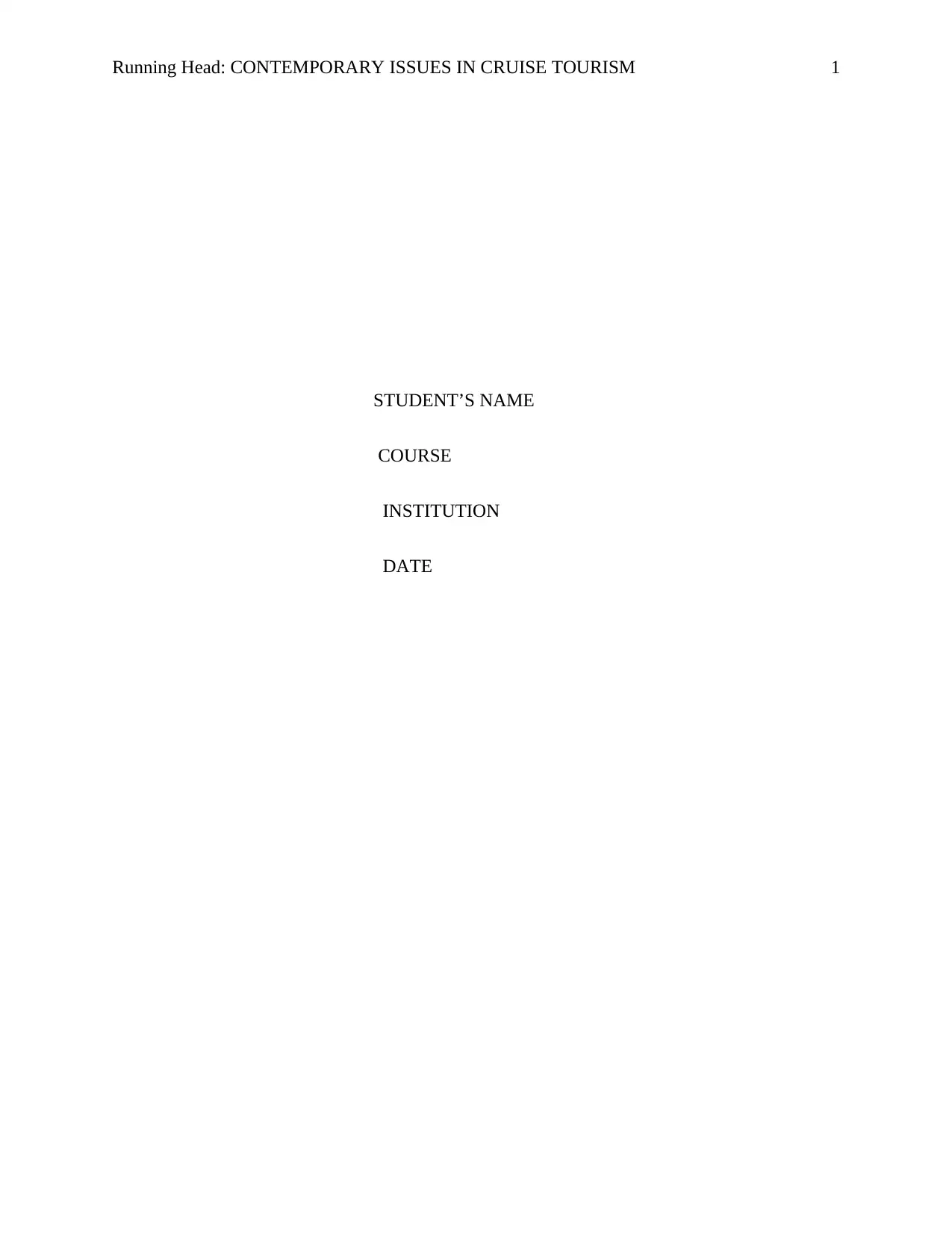
Running Head: CONTEMPORARY ISSUES IN CRUISE TOURISM 1
STUDENT’S NAME
COURSE
INSTITUTION
DATE
STUDENT’S NAME
COURSE
INSTITUTION
DATE
Paraphrase This Document
Need a fresh take? Get an instant paraphrase of this document with our AI Paraphraser

2
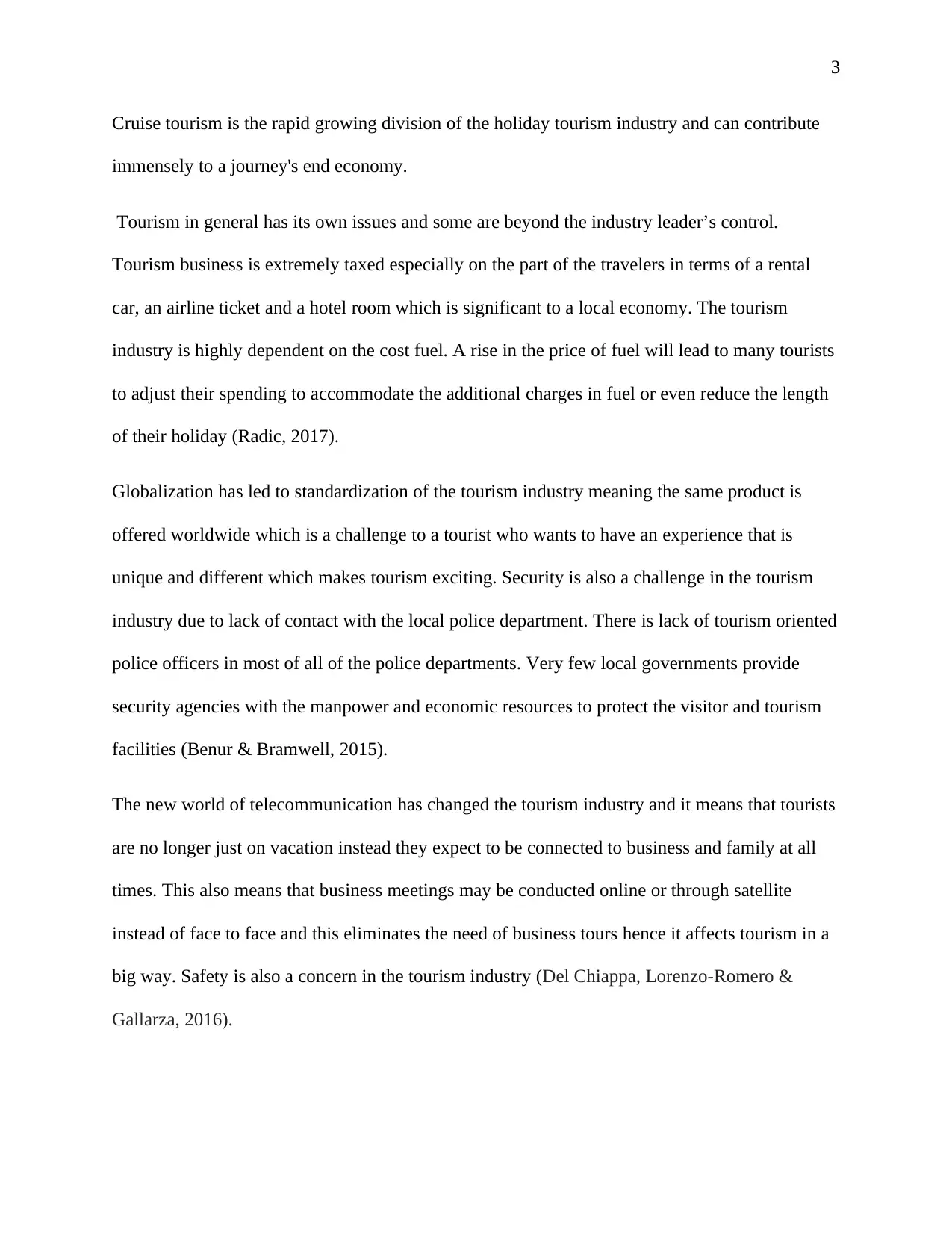
3
Cruise tourism is the rapid growing division of the holiday tourism industry and can contribute
immensely to a journey's end economy.
Tourism in general has its own issues and some are beyond the industry leader’s control.
Tourism business is extremely taxed especially on the part of the travelers in terms of a rental
car, an airline ticket and a hotel room which is significant to a local economy. The tourism
industry is highly dependent on the cost fuel. A rise in the price of fuel will lead to many tourists
to adjust their spending to accommodate the additional charges in fuel or even reduce the length
of their holiday (Radic, 2017).
Globalization has led to standardization of the tourism industry meaning the same product is
offered worldwide which is a challenge to a tourist who wants to have an experience that is
unique and different which makes tourism exciting. Security is also a challenge in the tourism
industry due to lack of contact with the local police department. There is lack of tourism oriented
police officers in most of all of the police departments. Very few local governments provide
security agencies with the manpower and economic resources to protect the visitor and tourism
facilities (Benur & Bramwell, 2015).
The new world of telecommunication has changed the tourism industry and it means that tourists
are no longer just on vacation instead they expect to be connected to business and family at all
times. This also means that business meetings may be conducted online or through satellite
instead of face to face and this eliminates the need of business tours hence it affects tourism in a
big way. Safety is also a concern in the tourism industry (Del Chiappa, Lorenzo-Romero &
Gallarza, 2016).
Cruise tourism is the rapid growing division of the holiday tourism industry and can contribute
immensely to a journey's end economy.
Tourism in general has its own issues and some are beyond the industry leader’s control.
Tourism business is extremely taxed especially on the part of the travelers in terms of a rental
car, an airline ticket and a hotel room which is significant to a local economy. The tourism
industry is highly dependent on the cost fuel. A rise in the price of fuel will lead to many tourists
to adjust their spending to accommodate the additional charges in fuel or even reduce the length
of their holiday (Radic, 2017).
Globalization has led to standardization of the tourism industry meaning the same product is
offered worldwide which is a challenge to a tourist who wants to have an experience that is
unique and different which makes tourism exciting. Security is also a challenge in the tourism
industry due to lack of contact with the local police department. There is lack of tourism oriented
police officers in most of all of the police departments. Very few local governments provide
security agencies with the manpower and economic resources to protect the visitor and tourism
facilities (Benur & Bramwell, 2015).
The new world of telecommunication has changed the tourism industry and it means that tourists
are no longer just on vacation instead they expect to be connected to business and family at all
times. This also means that business meetings may be conducted online or through satellite
instead of face to face and this eliminates the need of business tours hence it affects tourism in a
big way. Safety is also a concern in the tourism industry (Del Chiappa, Lorenzo-Romero &
Gallarza, 2016).
⊘ This is a preview!⊘
Do you want full access?
Subscribe today to unlock all pages.

Trusted by 1+ million students worldwide
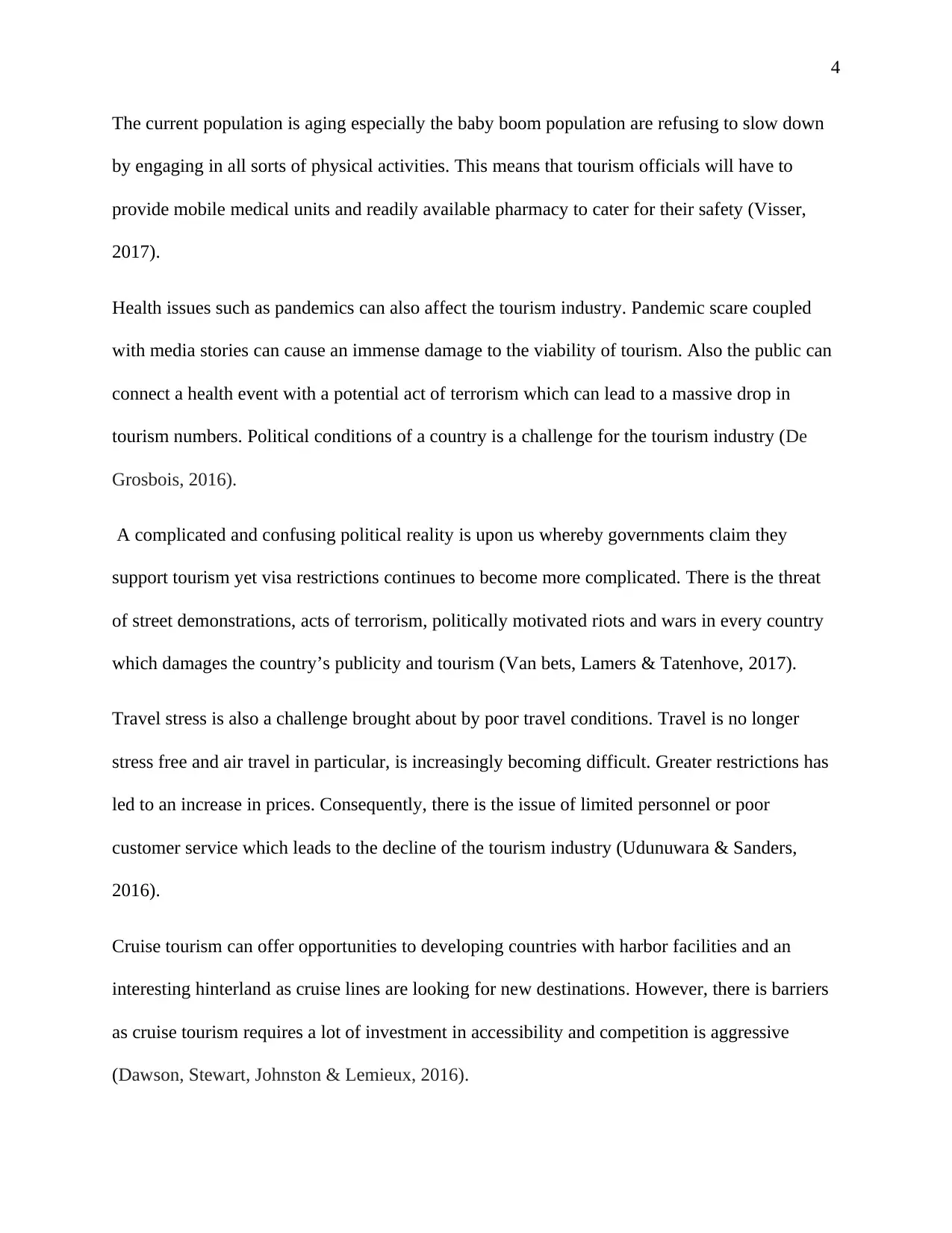
4
The current population is aging especially the baby boom population are refusing to slow down
by engaging in all sorts of physical activities. This means that tourism officials will have to
provide mobile medical units and readily available pharmacy to cater for their safety (Visser,
2017).
Health issues such as pandemics can also affect the tourism industry. Pandemic scare coupled
with media stories can cause an immense damage to the viability of tourism. Also the public can
connect a health event with a potential act of terrorism which can lead to a massive drop in
tourism numbers. Political conditions of a country is a challenge for the tourism industry (De
Grosbois, 2016).
A complicated and confusing political reality is upon us whereby governments claim they
support tourism yet visa restrictions continues to become more complicated. There is the threat
of street demonstrations, acts of terrorism, politically motivated riots and wars in every country
which damages the country’s publicity and tourism (Van bets, Lamers & Tatenhove, 2017).
Travel stress is also a challenge brought about by poor travel conditions. Travel is no longer
stress free and air travel in particular, is increasingly becoming difficult. Greater restrictions has
led to an increase in prices. Consequently, there is the issue of limited personnel or poor
customer service which leads to the decline of the tourism industry (Udunuwara & Sanders,
2016).
Cruise tourism can offer opportunities to developing countries with harbor facilities and an
interesting hinterland as cruise lines are looking for new destinations. However, there is barriers
as cruise tourism requires a lot of investment in accessibility and competition is aggressive
(Dawson, Stewart, Johnston & Lemieux, 2016).
The current population is aging especially the baby boom population are refusing to slow down
by engaging in all sorts of physical activities. This means that tourism officials will have to
provide mobile medical units and readily available pharmacy to cater for their safety (Visser,
2017).
Health issues such as pandemics can also affect the tourism industry. Pandemic scare coupled
with media stories can cause an immense damage to the viability of tourism. Also the public can
connect a health event with a potential act of terrorism which can lead to a massive drop in
tourism numbers. Political conditions of a country is a challenge for the tourism industry (De
Grosbois, 2016).
A complicated and confusing political reality is upon us whereby governments claim they
support tourism yet visa restrictions continues to become more complicated. There is the threat
of street demonstrations, acts of terrorism, politically motivated riots and wars in every country
which damages the country’s publicity and tourism (Van bets, Lamers & Tatenhove, 2017).
Travel stress is also a challenge brought about by poor travel conditions. Travel is no longer
stress free and air travel in particular, is increasingly becoming difficult. Greater restrictions has
led to an increase in prices. Consequently, there is the issue of limited personnel or poor
customer service which leads to the decline of the tourism industry (Udunuwara & Sanders,
2016).
Cruise tourism can offer opportunities to developing countries with harbor facilities and an
interesting hinterland as cruise lines are looking for new destinations. However, there is barriers
as cruise tourism requires a lot of investment in accessibility and competition is aggressive
(Dawson, Stewart, Johnston & Lemieux, 2016).
Paraphrase This Document
Need a fresh take? Get an instant paraphrase of this document with our AI Paraphraser
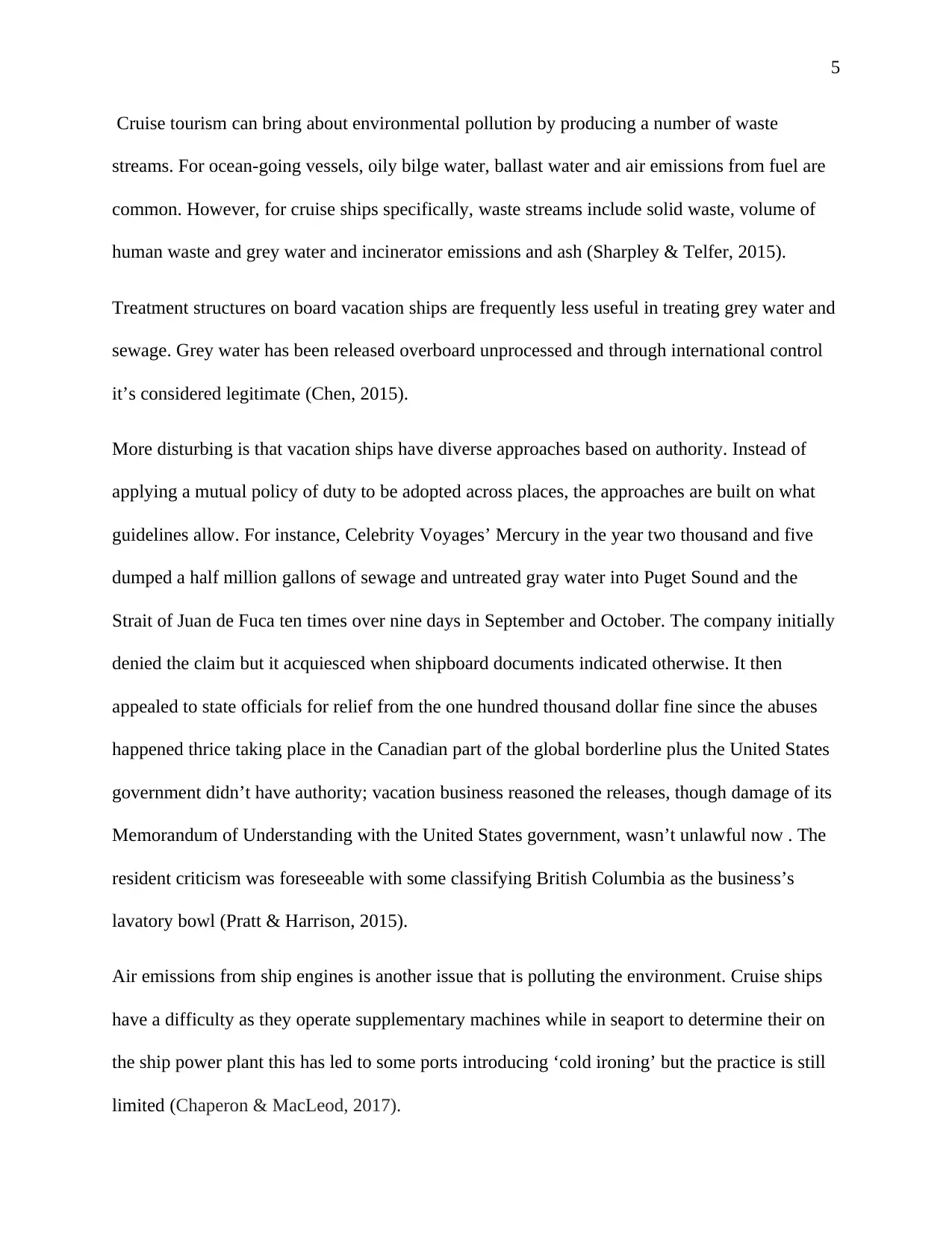
5
Cruise tourism can bring about environmental pollution by producing a number of waste
streams. For ocean-going vessels, oily bilge water, ballast water and air emissions from fuel are
common. However, for cruise ships specifically, waste streams include solid waste, volume of
human waste and grey water and incinerator emissions and ash (Sharpley & Telfer, 2015).
Treatment structures on board vacation ships are frequently less useful in treating grey water and
sewage. Grey water has been released overboard unprocessed and through international control
it’s considered legitimate (Chen, 2015).
More disturbing is that vacation ships have diverse approaches based on authority. Instead of
applying a mutual policy of duty to be adopted across places, the approaches are built on what
guidelines allow. For instance, Celebrity Voyages’ Mercury in the year two thousand and five
dumped a half million gallons of sewage and untreated gray water into Puget Sound and the
Strait of Juan de Fuca ten times over nine days in September and October. The company initially
denied the claim but it acquiesced when shipboard documents indicated otherwise. It then
appealed to state officials for relief from the one hundred thousand dollar fine since the abuses
happened thrice taking place in the Canadian part of the global borderline plus the United States
government didn’t have authority; vacation business reasoned the releases, though damage of its
Memorandum of Understanding with the United States government, wasn’t unlawful now . The
resident criticism was foreseeable with some classifying British Columbia as the business’s
lavatory bowl (Pratt & Harrison, 2015).
Air emissions from ship engines is another issue that is polluting the environment. Cruise ships
have a difficulty as they operate supplementary machines while in seaport to determine their on
the ship power plant this has led to some ports introducing ‘cold ironing’ but the practice is still
limited (Chaperon & MacLeod, 2017).
Cruise tourism can bring about environmental pollution by producing a number of waste
streams. For ocean-going vessels, oily bilge water, ballast water and air emissions from fuel are
common. However, for cruise ships specifically, waste streams include solid waste, volume of
human waste and grey water and incinerator emissions and ash (Sharpley & Telfer, 2015).
Treatment structures on board vacation ships are frequently less useful in treating grey water and
sewage. Grey water has been released overboard unprocessed and through international control
it’s considered legitimate (Chen, 2015).
More disturbing is that vacation ships have diverse approaches based on authority. Instead of
applying a mutual policy of duty to be adopted across places, the approaches are built on what
guidelines allow. For instance, Celebrity Voyages’ Mercury in the year two thousand and five
dumped a half million gallons of sewage and untreated gray water into Puget Sound and the
Strait of Juan de Fuca ten times over nine days in September and October. The company initially
denied the claim but it acquiesced when shipboard documents indicated otherwise. It then
appealed to state officials for relief from the one hundred thousand dollar fine since the abuses
happened thrice taking place in the Canadian part of the global borderline plus the United States
government didn’t have authority; vacation business reasoned the releases, though damage of its
Memorandum of Understanding with the United States government, wasn’t unlawful now . The
resident criticism was foreseeable with some classifying British Columbia as the business’s
lavatory bowl (Pratt & Harrison, 2015).
Air emissions from ship engines is another issue that is polluting the environment. Cruise ships
have a difficulty as they operate supplementary machines while in seaport to determine their on
the ship power plant this has led to some ports introducing ‘cold ironing’ but the practice is still
limited (Chaperon & MacLeod, 2017).
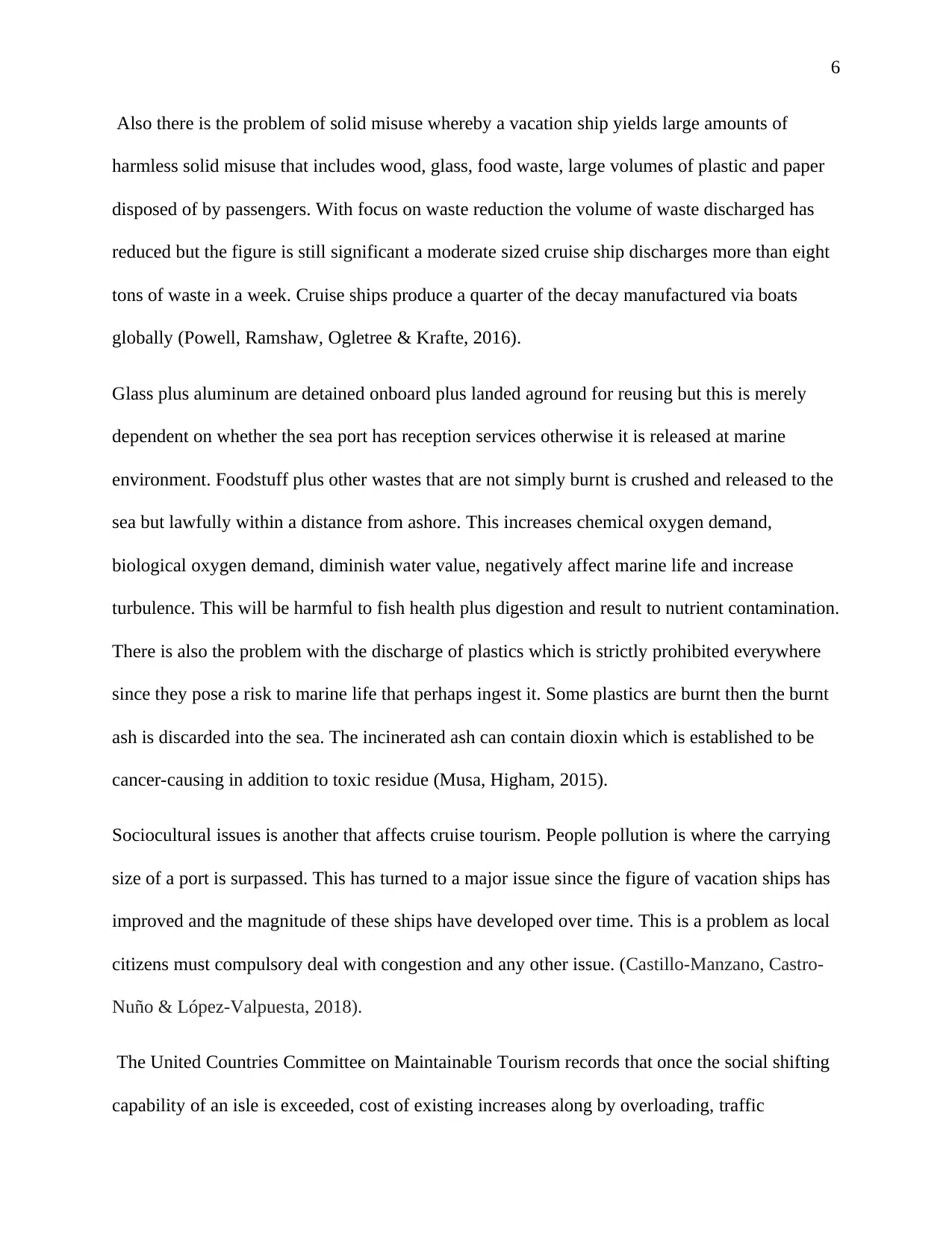
6
Also there is the problem of solid misuse whereby a vacation ship yields large amounts of
harmless solid misuse that includes wood, glass, food waste, large volumes of plastic and paper
disposed of by passengers. With focus on waste reduction the volume of waste discharged has
reduced but the figure is still significant a moderate sized cruise ship discharges more than eight
tons of waste in a week. Cruise ships produce a quarter of the decay manufactured via boats
globally (Powell, Ramshaw, Ogletree & Krafte, 2016).
Glass plus aluminum are detained onboard plus landed aground for reusing but this is merely
dependent on whether the sea port has reception services otherwise it is released at marine
environment. Foodstuff plus other wastes that are not simply burnt is crushed and released to the
sea but lawfully within a distance from ashore. This increases chemical oxygen demand,
biological oxygen demand, diminish water value, negatively affect marine life and increase
turbulence. This will be harmful to fish health plus digestion and result to nutrient contamination.
There is also the problem with the discharge of plastics which is strictly prohibited everywhere
since they pose a risk to marine life that perhaps ingest it. Some plastics are burnt then the burnt
ash is discarded into the sea. The incinerated ash can contain dioxin which is established to be
cancer-causing in addition to toxic residue (Musa, Higham, 2015).
Sociocultural issues is another that affects cruise tourism. People pollution is where the carrying
size of a port is surpassed. This has turned to a major issue since the figure of vacation ships has
improved and the magnitude of these ships have developed over time. This is a problem as local
citizens must compulsory deal with congestion and any other issue. (Castillo-Manzano, Castro-
Nuño & López-Valpuesta, 2018).
The United Countries Committee on Maintainable Tourism records that once the social shifting
capability of an isle is exceeded, cost of existing increases along by overloading, traffic
Also there is the problem of solid misuse whereby a vacation ship yields large amounts of
harmless solid misuse that includes wood, glass, food waste, large volumes of plastic and paper
disposed of by passengers. With focus on waste reduction the volume of waste discharged has
reduced but the figure is still significant a moderate sized cruise ship discharges more than eight
tons of waste in a week. Cruise ships produce a quarter of the decay manufactured via boats
globally (Powell, Ramshaw, Ogletree & Krafte, 2016).
Glass plus aluminum are detained onboard plus landed aground for reusing but this is merely
dependent on whether the sea port has reception services otherwise it is released at marine
environment. Foodstuff plus other wastes that are not simply burnt is crushed and released to the
sea but lawfully within a distance from ashore. This increases chemical oxygen demand,
biological oxygen demand, diminish water value, negatively affect marine life and increase
turbulence. This will be harmful to fish health plus digestion and result to nutrient contamination.
There is also the problem with the discharge of plastics which is strictly prohibited everywhere
since they pose a risk to marine life that perhaps ingest it. Some plastics are burnt then the burnt
ash is discarded into the sea. The incinerated ash can contain dioxin which is established to be
cancer-causing in addition to toxic residue (Musa, Higham, 2015).
Sociocultural issues is another that affects cruise tourism. People pollution is where the carrying
size of a port is surpassed. This has turned to a major issue since the figure of vacation ships has
improved and the magnitude of these ships have developed over time. This is a problem as local
citizens must compulsory deal with congestion and any other issue. (Castillo-Manzano, Castro-
Nuño & López-Valpuesta, 2018).
The United Countries Committee on Maintainable Tourism records that once the social shifting
capability of an isle is exceeded, cost of existing increases along by overloading, traffic
⊘ This is a preview!⊘
Do you want full access?
Subscribe today to unlock all pages.

Trusted by 1+ million students worldwide
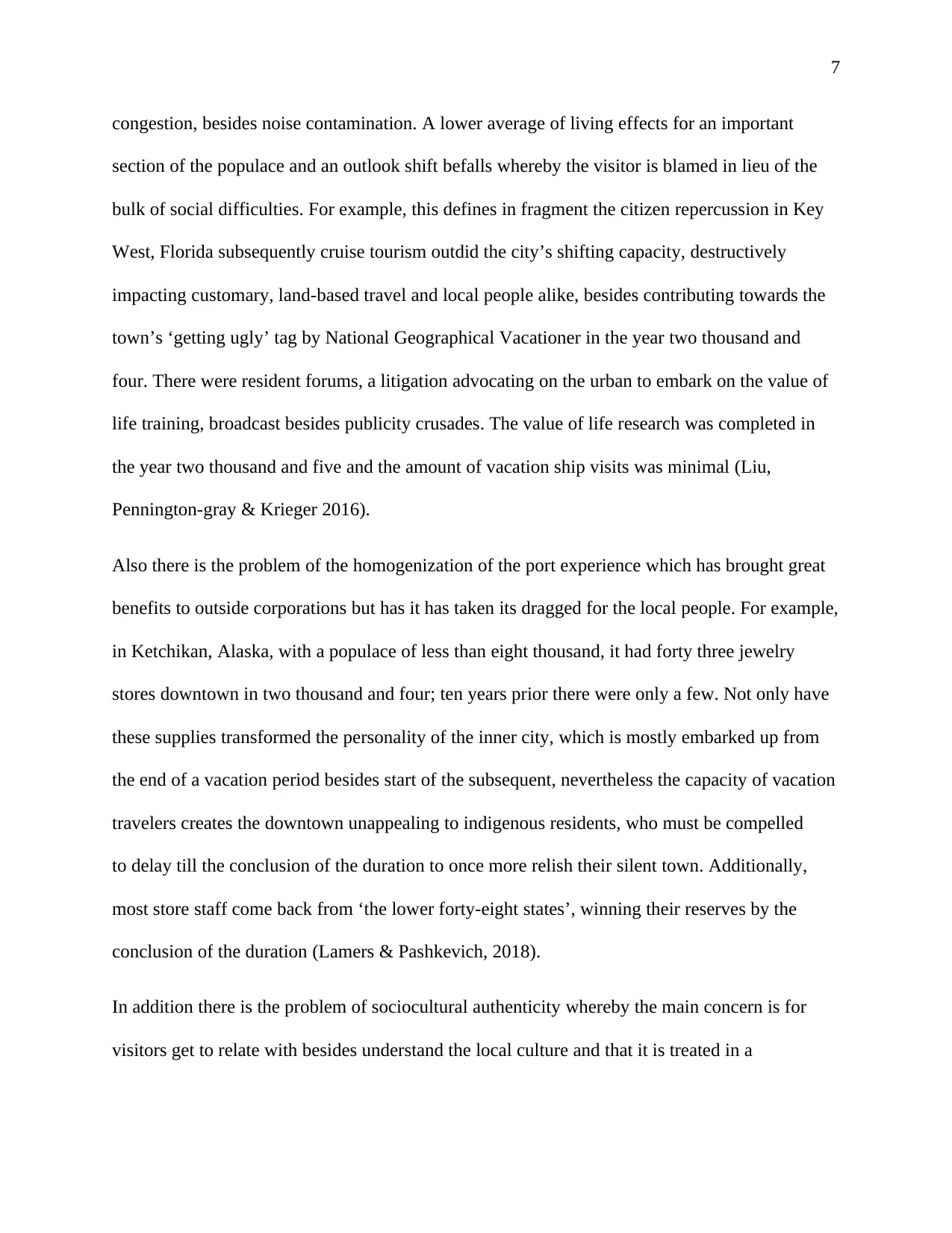
7
congestion, besides noise contamination. A lower average of living effects for an important
section of the populace and an outlook shift befalls whereby the visitor is blamed in lieu of the
bulk of social difficulties. For example, this defines in fragment the citizen repercussion in Key
West, Florida subsequently cruise tourism outdid the city’s shifting capacity, destructively
impacting customary, land-based travel and local people alike, besides contributing towards the
town’s ‘getting ugly’ tag by National Geographical Vacationer in the year two thousand and
four. There were resident forums, a litigation advocating on the urban to embark on the value of
life training, broadcast besides publicity crusades. The value of life research was completed in
the year two thousand and five and the amount of vacation ship visits was minimal (Liu,
Pennington-gray & Krieger 2016).
Also there is the problem of the homogenization of the port experience which has brought great
benefits to outside corporations but has it has taken its dragged for the local people. For example,
in Ketchikan, Alaska, with a populace of less than eight thousand, it had forty three jewelry
stores downtown in two thousand and four; ten years prior there were only a few. Not only have
these supplies transformed the personality of the inner city, which is mostly embarked up from
the end of a vacation period besides start of the subsequent, nevertheless the capacity of vacation
travelers creates the downtown unappealing to indigenous residents, who must be compelled
to delay till the conclusion of the duration to once more relish their silent town. Additionally,
most store staff come back from ‘the lower forty-eight states’, winning their reserves by the
conclusion of the duration (Lamers & Pashkevich, 2018).
In addition there is the problem of sociocultural authenticity whereby the main concern is for
visitors get to relate with besides understand the local culture and that it is treated in a
congestion, besides noise contamination. A lower average of living effects for an important
section of the populace and an outlook shift befalls whereby the visitor is blamed in lieu of the
bulk of social difficulties. For example, this defines in fragment the citizen repercussion in Key
West, Florida subsequently cruise tourism outdid the city’s shifting capacity, destructively
impacting customary, land-based travel and local people alike, besides contributing towards the
town’s ‘getting ugly’ tag by National Geographical Vacationer in the year two thousand and
four. There were resident forums, a litigation advocating on the urban to embark on the value of
life training, broadcast besides publicity crusades. The value of life research was completed in
the year two thousand and five and the amount of vacation ship visits was minimal (Liu,
Pennington-gray & Krieger 2016).
Also there is the problem of the homogenization of the port experience which has brought great
benefits to outside corporations but has it has taken its dragged for the local people. For example,
in Ketchikan, Alaska, with a populace of less than eight thousand, it had forty three jewelry
stores downtown in two thousand and four; ten years prior there were only a few. Not only have
these supplies transformed the personality of the inner city, which is mostly embarked up from
the end of a vacation period besides start of the subsequent, nevertheless the capacity of vacation
travelers creates the downtown unappealing to indigenous residents, who must be compelled
to delay till the conclusion of the duration to once more relish their silent town. Additionally,
most store staff come back from ‘the lower forty-eight states’, winning their reserves by the
conclusion of the duration (Lamers & Pashkevich, 2018).
In addition there is the problem of sociocultural authenticity whereby the main concern is for
visitors get to relate with besides understand the local culture and that it is treated in a
Paraphrase This Document
Need a fresh take? Get an instant paraphrase of this document with our AI Paraphraser
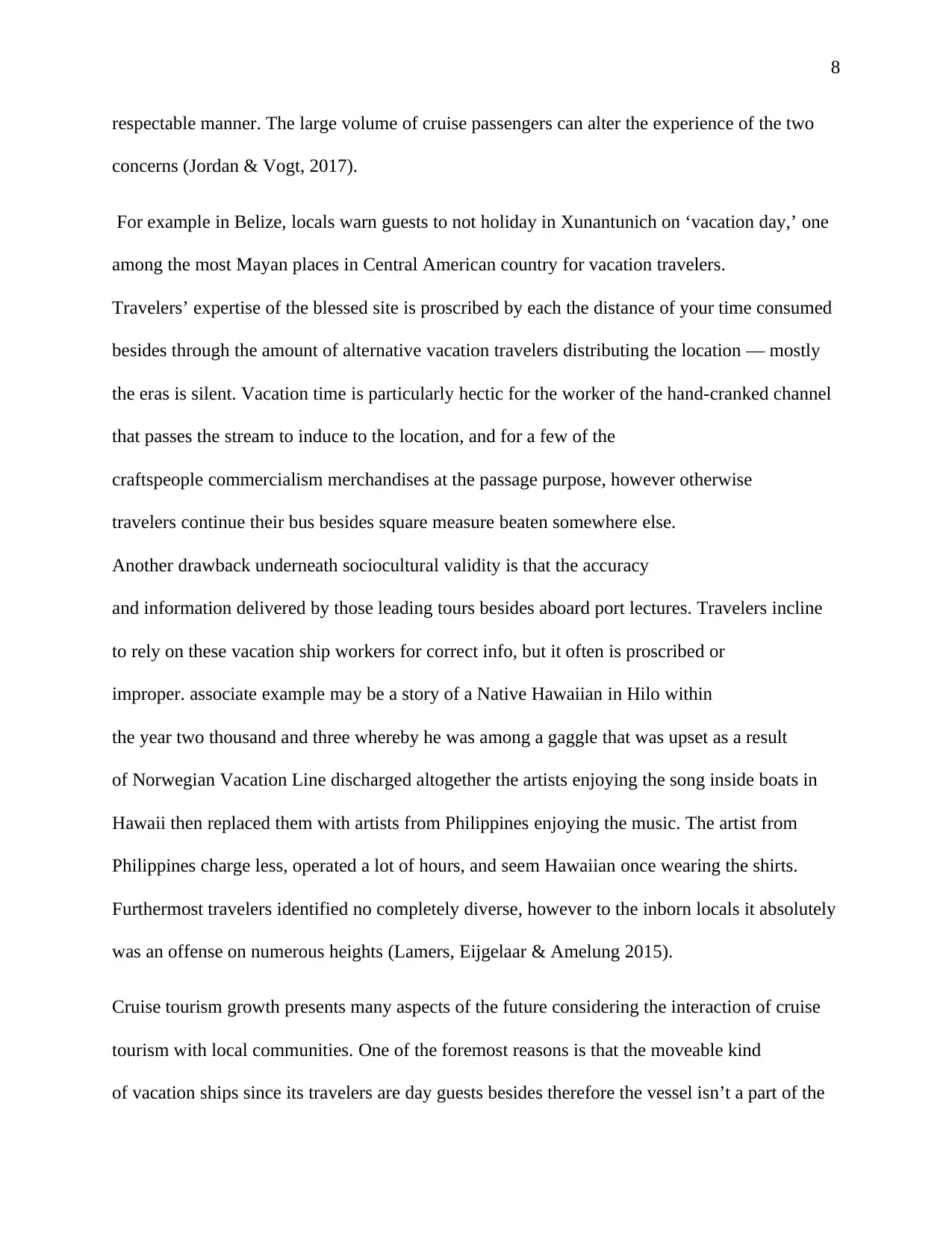
8
respectable manner. The large volume of cruise passengers can alter the experience of the two
concerns (Jordan & Vogt, 2017).
For example in Belize, locals warn guests to not holiday in Xunantunich on ‘vacation day,’ one
among the most Mayan places in Central American country for vacation travelers.
Travelers’ expertise of the blessed site is proscribed by each the distance of your time consumed
besides through the amount of alternative vacation travelers distributing the location — mostly
the eras is silent. Vacation time is particularly hectic for the worker of the hand-cranked channel
that passes the stream to induce to the location, and for a few of the
craftspeople commercialism merchandises at the passage purpose, however otherwise
travelers continue their bus besides square measure beaten somewhere else.
Another drawback underneath sociocultural validity is that the accuracy
and information delivered by those leading tours besides aboard port lectures. Travelers incline
to rely on these vacation ship workers for correct info, but it often is proscribed or
improper. associate example may be a story of a Native Hawaiian in Hilo within
the year two thousand and three whereby he was among a gaggle that was upset as a result
of Norwegian Vacation Line discharged altogether the artists enjoying the song inside boats in
Hawaii then replaced them with artists from Philippines enjoying the music. The artist from
Philippines charge less, operated a lot of hours, and seem Hawaiian once wearing the shirts.
Furthermost travelers identified no completely diverse, however to the inborn locals it absolutely
was an offense on numerous heights (Lamers, Eijgelaar & Amelung 2015).
Cruise tourism growth presents many aspects of the future considering the interaction of cruise
tourism with local communities. One of the foremost reasons is that the moveable kind
of vacation ships since its travelers are day guests besides therefore the vessel isn’t a part of the
respectable manner. The large volume of cruise passengers can alter the experience of the two
concerns (Jordan & Vogt, 2017).
For example in Belize, locals warn guests to not holiday in Xunantunich on ‘vacation day,’ one
among the most Mayan places in Central American country for vacation travelers.
Travelers’ expertise of the blessed site is proscribed by each the distance of your time consumed
besides through the amount of alternative vacation travelers distributing the location — mostly
the eras is silent. Vacation time is particularly hectic for the worker of the hand-cranked channel
that passes the stream to induce to the location, and for a few of the
craftspeople commercialism merchandises at the passage purpose, however otherwise
travelers continue their bus besides square measure beaten somewhere else.
Another drawback underneath sociocultural validity is that the accuracy
and information delivered by those leading tours besides aboard port lectures. Travelers incline
to rely on these vacation ship workers for correct info, but it often is proscribed or
improper. associate example may be a story of a Native Hawaiian in Hilo within
the year two thousand and three whereby he was among a gaggle that was upset as a result
of Norwegian Vacation Line discharged altogether the artists enjoying the song inside boats in
Hawaii then replaced them with artists from Philippines enjoying the music. The artist from
Philippines charge less, operated a lot of hours, and seem Hawaiian once wearing the shirts.
Furthermost travelers identified no completely diverse, however to the inborn locals it absolutely
was an offense on numerous heights (Lamers, Eijgelaar & Amelung 2015).
Cruise tourism growth presents many aspects of the future considering the interaction of cruise
tourism with local communities. One of the foremost reasons is that the moveable kind
of vacation ships since its travelers are day guests besides therefore the vessel isn’t a part of the
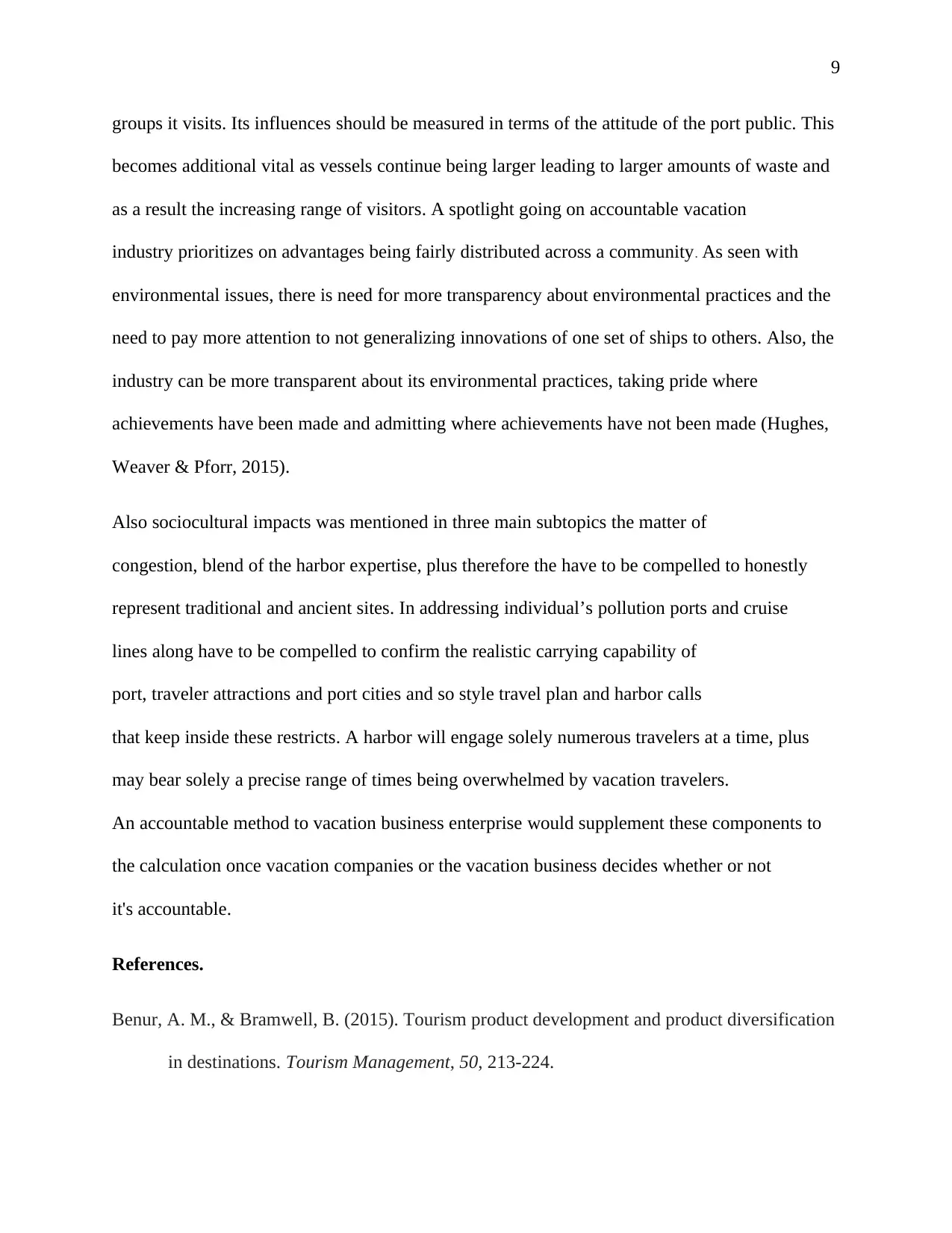
9
groups it visits. Its influences should be measured in terms of the attitude of the port public. This
becomes additional vital as vessels continue being larger leading to larger amounts of waste and
as a result the increasing range of visitors. A spotlight going on accountable vacation
industry prioritizes on advantages being fairly distributed across a community. As seen with
environmental issues, there is need for more transparency about environmental practices and the
need to pay more attention to not generalizing innovations of one set of ships to others. Also, the
industry can be more transparent about its environmental practices, taking pride where
achievements have been made and admitting where achievements have not been made (Hughes,
Weaver & Pforr, 2015).
Also sociocultural impacts was mentioned in three main subtopics the matter of
congestion, blend of the harbor expertise, plus therefore the have to be compelled to honestly
represent traditional and ancient sites. In addressing individual’s pollution ports and cruise
lines along have to be compelled to confirm the realistic carrying capability of
port, traveler attractions and port cities and so style travel plan and harbor calls
that keep inside these restricts. A harbor will engage solely numerous travelers at a time, plus
may bear solely a precise range of times being overwhelmed by vacation travelers.
An accountable method to vacation business enterprise would supplement these components to
the calculation once vacation companies or the vacation business decides whether or not
it's accountable.
References.
Benur, A. M., & Bramwell, B. (2015). Tourism product development and product diversification
in destinations. Tourism Management, 50, 213-224.
groups it visits. Its influences should be measured in terms of the attitude of the port public. This
becomes additional vital as vessels continue being larger leading to larger amounts of waste and
as a result the increasing range of visitors. A spotlight going on accountable vacation
industry prioritizes on advantages being fairly distributed across a community. As seen with
environmental issues, there is need for more transparency about environmental practices and the
need to pay more attention to not generalizing innovations of one set of ships to others. Also, the
industry can be more transparent about its environmental practices, taking pride where
achievements have been made and admitting where achievements have not been made (Hughes,
Weaver & Pforr, 2015).
Also sociocultural impacts was mentioned in three main subtopics the matter of
congestion, blend of the harbor expertise, plus therefore the have to be compelled to honestly
represent traditional and ancient sites. In addressing individual’s pollution ports and cruise
lines along have to be compelled to confirm the realistic carrying capability of
port, traveler attractions and port cities and so style travel plan and harbor calls
that keep inside these restricts. A harbor will engage solely numerous travelers at a time, plus
may bear solely a precise range of times being overwhelmed by vacation travelers.
An accountable method to vacation business enterprise would supplement these components to
the calculation once vacation companies or the vacation business decides whether or not
it's accountable.
References.
Benur, A. M., & Bramwell, B. (2015). Tourism product development and product diversification
in destinations. Tourism Management, 50, 213-224.
⊘ This is a preview!⊘
Do you want full access?
Subscribe today to unlock all pages.

Trusted by 1+ million students worldwide
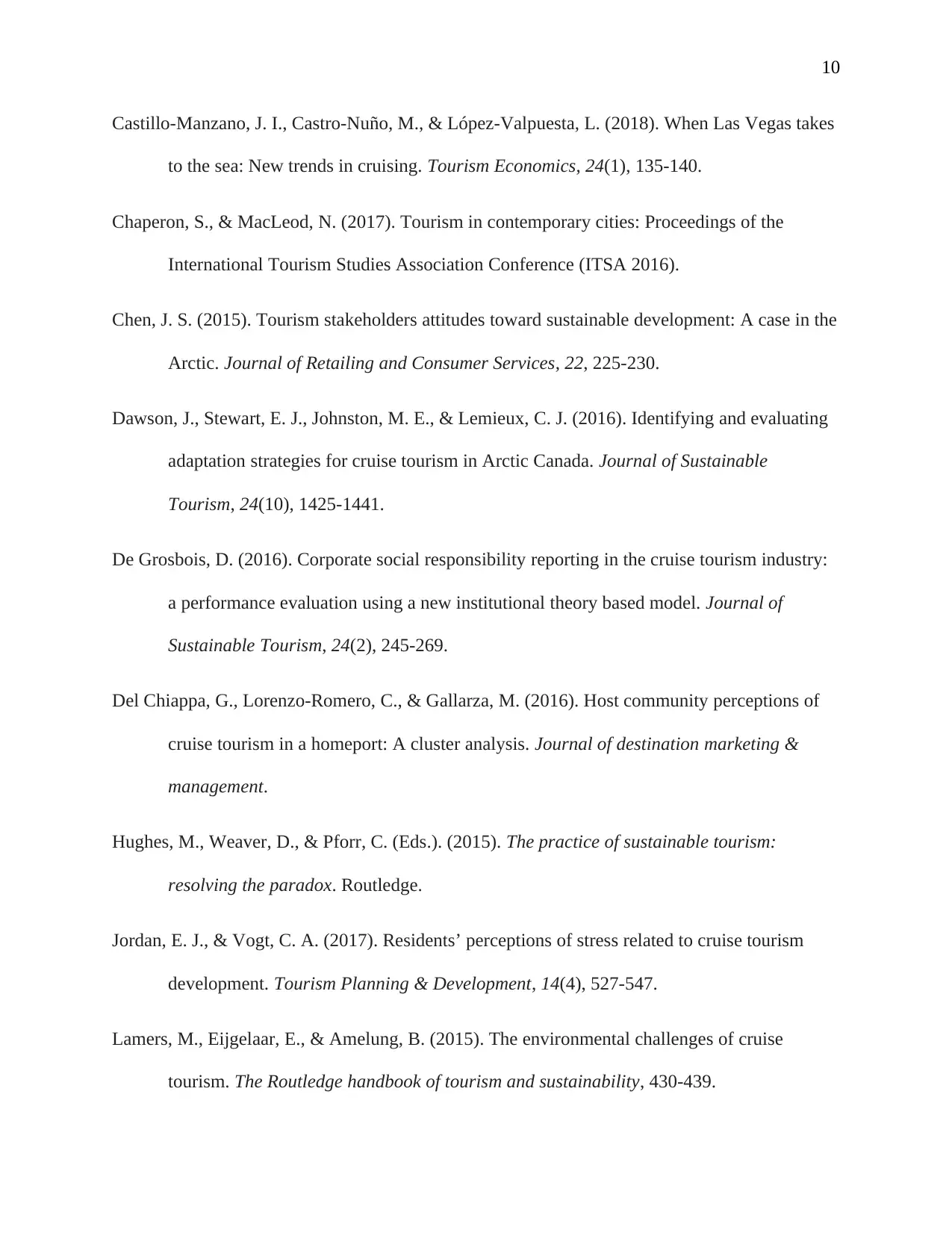
10
Castillo-Manzano, J. I., Castro-Nuño, M., & López-Valpuesta, L. (2018). When Las Vegas takes
to the sea: New trends in cruising. Tourism Economics, 24(1), 135-140.
Chaperon, S., & MacLeod, N. (2017). Tourism in contemporary cities: Proceedings of the
International Tourism Studies Association Conference (ITSA 2016).
Chen, J. S. (2015). Tourism stakeholders attitudes toward sustainable development: A case in the
Arctic. Journal of Retailing and Consumer Services, 22, 225-230.
Dawson, J., Stewart, E. J., Johnston, M. E., & Lemieux, C. J. (2016). Identifying and evaluating
adaptation strategies for cruise tourism in Arctic Canada. Journal of Sustainable
Tourism, 24(10), 1425-1441.
De Grosbois, D. (2016). Corporate social responsibility reporting in the cruise tourism industry:
a performance evaluation using a new institutional theory based model. Journal of
Sustainable Tourism, 24(2), 245-269.
Del Chiappa, G., Lorenzo-Romero, C., & Gallarza, M. (2016). Host community perceptions of
cruise tourism in a homeport: A cluster analysis. Journal of destination marketing &
management.
Hughes, M., Weaver, D., & Pforr, C. (Eds.). (2015). The practice of sustainable tourism:
resolving the paradox. Routledge.
Jordan, E. J., & Vogt, C. A. (2017). Residents’ perceptions of stress related to cruise tourism
development. Tourism Planning & Development, 14(4), 527-547.
Lamers, M., Eijgelaar, E., & Amelung, B. (2015). The environmental challenges of cruise
tourism. The Routledge handbook of tourism and sustainability, 430-439.
Castillo-Manzano, J. I., Castro-Nuño, M., & López-Valpuesta, L. (2018). When Las Vegas takes
to the sea: New trends in cruising. Tourism Economics, 24(1), 135-140.
Chaperon, S., & MacLeod, N. (2017). Tourism in contemporary cities: Proceedings of the
International Tourism Studies Association Conference (ITSA 2016).
Chen, J. S. (2015). Tourism stakeholders attitudes toward sustainable development: A case in the
Arctic. Journal of Retailing and Consumer Services, 22, 225-230.
Dawson, J., Stewart, E. J., Johnston, M. E., & Lemieux, C. J. (2016). Identifying and evaluating
adaptation strategies for cruise tourism in Arctic Canada. Journal of Sustainable
Tourism, 24(10), 1425-1441.
De Grosbois, D. (2016). Corporate social responsibility reporting in the cruise tourism industry:
a performance evaluation using a new institutional theory based model. Journal of
Sustainable Tourism, 24(2), 245-269.
Del Chiappa, G., Lorenzo-Romero, C., & Gallarza, M. (2016). Host community perceptions of
cruise tourism in a homeport: A cluster analysis. Journal of destination marketing &
management.
Hughes, M., Weaver, D., & Pforr, C. (Eds.). (2015). The practice of sustainable tourism:
resolving the paradox. Routledge.
Jordan, E. J., & Vogt, C. A. (2017). Residents’ perceptions of stress related to cruise tourism
development. Tourism Planning & Development, 14(4), 527-547.
Lamers, M., Eijgelaar, E., & Amelung, B. (2015). The environmental challenges of cruise
tourism. The Routledge handbook of tourism and sustainability, 430-439.
Paraphrase This Document
Need a fresh take? Get an instant paraphrase of this document with our AI Paraphraser
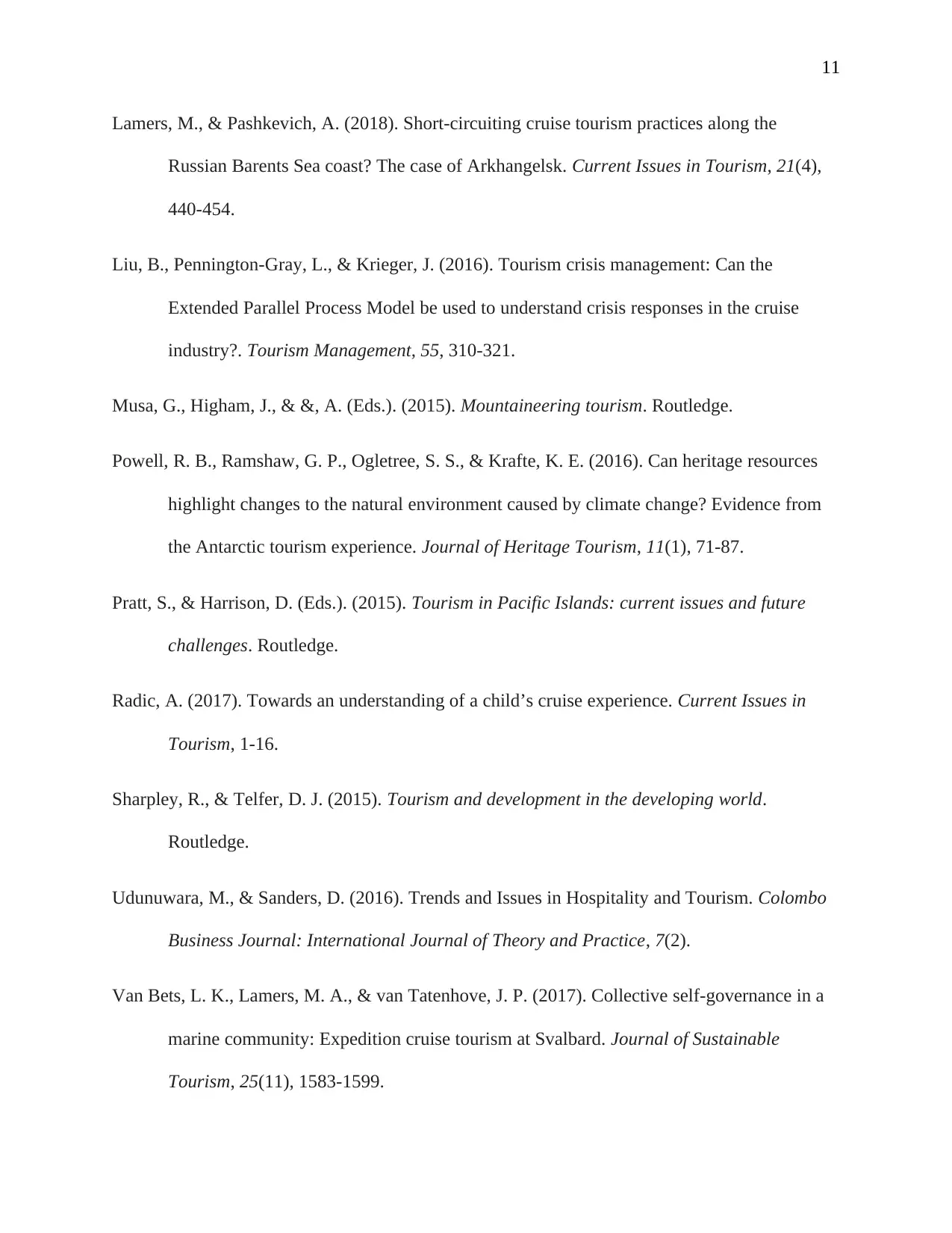
11
Lamers, M., & Pashkevich, A. (2018). Short-circuiting cruise tourism practices along the
Russian Barents Sea coast? The case of Arkhangelsk. Current Issues in Tourism, 21(4),
440-454.
Liu, B., Pennington-Gray, L., & Krieger, J. (2016). Tourism crisis management: Can the
Extended Parallel Process Model be used to understand crisis responses in the cruise
industry?. Tourism Management, 55, 310-321.
Musa, G., Higham, J., & &, A. (Eds.). (2015). Mountaineering tourism. Routledge.
Powell, R. B., Ramshaw, G. P., Ogletree, S. S., & Krafte, K. E. (2016). Can heritage resources
highlight changes to the natural environment caused by climate change? Evidence from
the Antarctic tourism experience. Journal of Heritage Tourism, 11(1), 71-87.
Pratt, S., & Harrison, D. (Eds.). (2015). Tourism in Pacific Islands: current issues and future
challenges. Routledge.
Radic, A. (2017). Towards an understanding of a child’s cruise experience. Current Issues in
Tourism, 1-16.
Sharpley, R., & Telfer, D. J. (2015). Tourism and development in the developing world.
Routledge.
Udunuwara, M., & Sanders, D. (2016). Trends and Issues in Hospitality and Tourism. Colombo
Business Journal: International Journal of Theory and Practice, 7(2).
Van Bets, L. K., Lamers, M. A., & van Tatenhove, J. P. (2017). Collective self-governance in a
marine community: Expedition cruise tourism at Svalbard. Journal of Sustainable
Tourism, 25(11), 1583-1599.
Lamers, M., & Pashkevich, A. (2018). Short-circuiting cruise tourism practices along the
Russian Barents Sea coast? The case of Arkhangelsk. Current Issues in Tourism, 21(4),
440-454.
Liu, B., Pennington-Gray, L., & Krieger, J. (2016). Tourism crisis management: Can the
Extended Parallel Process Model be used to understand crisis responses in the cruise
industry?. Tourism Management, 55, 310-321.
Musa, G., Higham, J., & &, A. (Eds.). (2015). Mountaineering tourism. Routledge.
Powell, R. B., Ramshaw, G. P., Ogletree, S. S., & Krafte, K. E. (2016). Can heritage resources
highlight changes to the natural environment caused by climate change? Evidence from
the Antarctic tourism experience. Journal of Heritage Tourism, 11(1), 71-87.
Pratt, S., & Harrison, D. (Eds.). (2015). Tourism in Pacific Islands: current issues and future
challenges. Routledge.
Radic, A. (2017). Towards an understanding of a child’s cruise experience. Current Issues in
Tourism, 1-16.
Sharpley, R., & Telfer, D. J. (2015). Tourism and development in the developing world.
Routledge.
Udunuwara, M., & Sanders, D. (2016). Trends and Issues in Hospitality and Tourism. Colombo
Business Journal: International Journal of Theory and Practice, 7(2).
Van Bets, L. K., Lamers, M. A., & van Tatenhove, J. P. (2017). Collective self-governance in a
marine community: Expedition cruise tourism at Svalbard. Journal of Sustainable
Tourism, 25(11), 1583-1599.
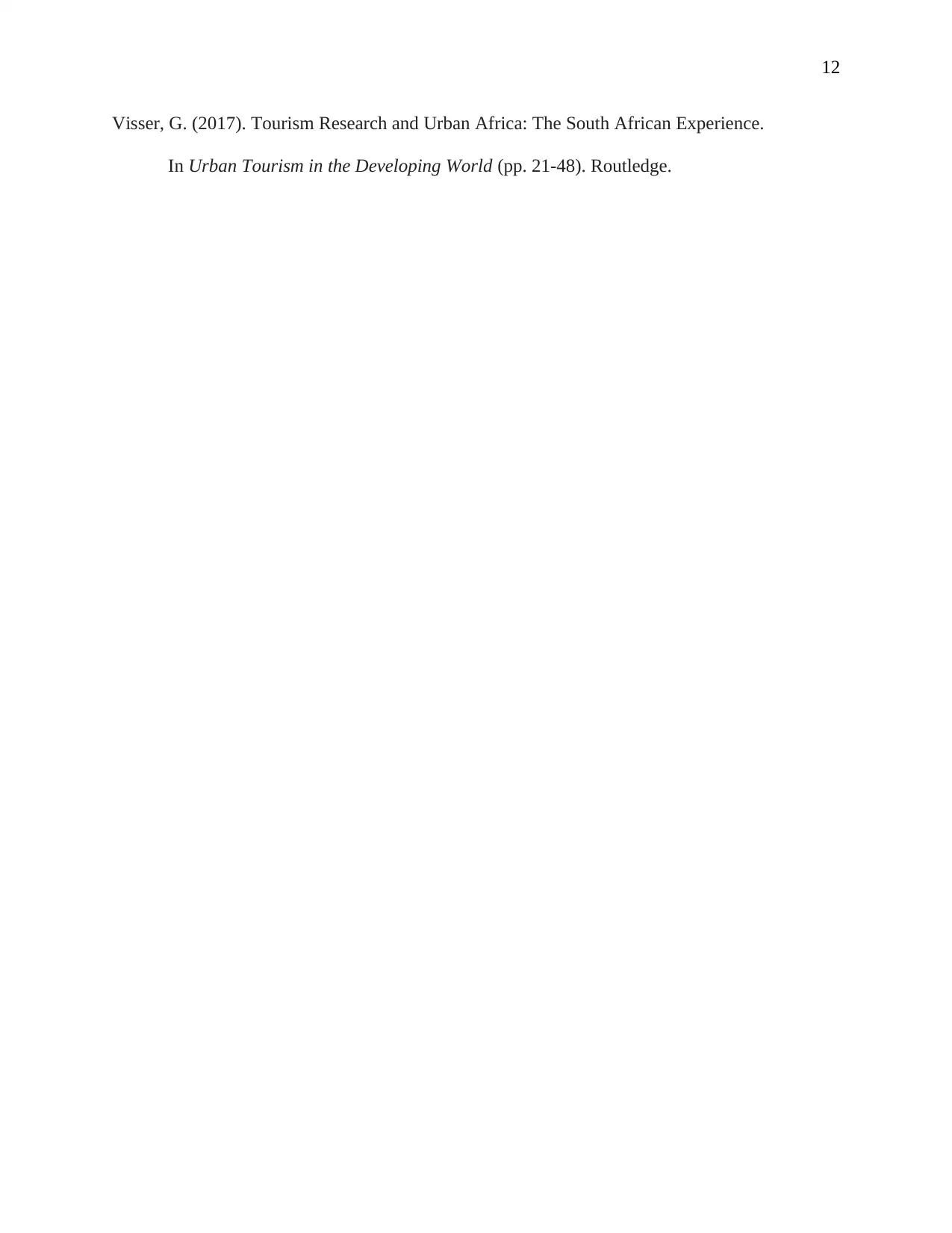
12
Visser, G. (2017). Tourism Research and Urban Africa: The South African Experience.
In Urban Tourism in the Developing World (pp. 21-48). Routledge.
Visser, G. (2017). Tourism Research and Urban Africa: The South African Experience.
In Urban Tourism in the Developing World (pp. 21-48). Routledge.
⊘ This is a preview!⊘
Do you want full access?
Subscribe today to unlock all pages.

Trusted by 1+ million students worldwide
1 out of 12
Related Documents
Your All-in-One AI-Powered Toolkit for Academic Success.
+13062052269
info@desklib.com
Available 24*7 on WhatsApp / Email
![[object Object]](/_next/static/media/star-bottom.7253800d.svg)
Unlock your academic potential
Copyright © 2020–2025 A2Z Services. All Rights Reserved. Developed and managed by ZUCOL.





